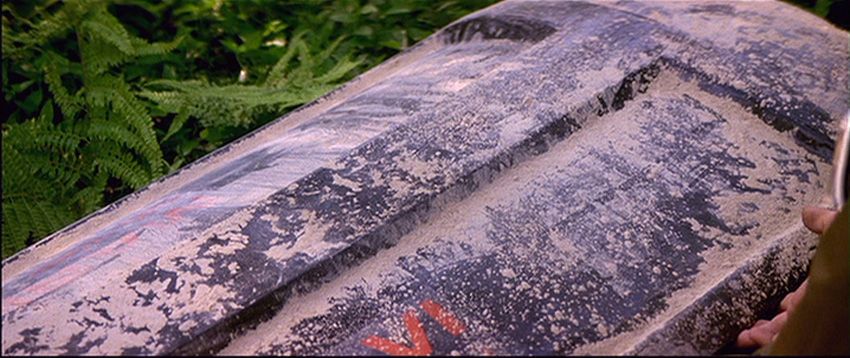...Something new ends up bugging me!
To be fair, this time, it wasn't something that I had really noticed before. One of the TV channels was showing TWOK (the regular version, not the DE unfortunately!) the other night, and as per usual, I ended up watching it (I'm quite confident I can recite every line in the movie).
It wasn't until the end of the movie that my "that's not right!" senses kicked in. Observe:

This is Spock's casket at the end of the movie, untarnished and perfectly intact on the surface of the Genesis planet. This works in favour of David's theory in TSFS that the tube soft landed when the gravitational fields were in flux. But! Then:

In TSFS, we see the casket, showing the effects of the elements OR burn damage from it being shot from Enterprise and/or entering the atmosphere of Genesis. As you can also see from this photo, David is about to open the casket, which comes across as being as simple as lifting the lid open. This raises the question as to how Spock's body managed to remain inside the casket during the transit. I mean, perhaps it didn't, he was found a distance away from the casket after all, but surely the Enterprise crew would have ensured that the casket was sealed shut? After all, it wasn't exactly a foregone conclusion that Spock would be resurrected and need to escape the coffin. You also have to consider his condition, specifically the fact that he'd still be emitting dangerous levels of ionised radiation for several hours at least, following his death. This would make the task of airtight sealing the casket, one of the utmost importance.
Thoughts?
To be fair, this time, it wasn't something that I had really noticed before. One of the TV channels was showing TWOK (the regular version, not the DE unfortunately!) the other night, and as per usual, I ended up watching it (I'm quite confident I can recite every line in the movie).
It wasn't until the end of the movie that my "that's not right!" senses kicked in. Observe:

This is Spock's casket at the end of the movie, untarnished and perfectly intact on the surface of the Genesis planet. This works in favour of David's theory in TSFS that the tube soft landed when the gravitational fields were in flux. But! Then:

In TSFS, we see the casket, showing the effects of the elements OR burn damage from it being shot from Enterprise and/or entering the atmosphere of Genesis. As you can also see from this photo, David is about to open the casket, which comes across as being as simple as lifting the lid open. This raises the question as to how Spock's body managed to remain inside the casket during the transit. I mean, perhaps it didn't, he was found a distance away from the casket after all, but surely the Enterprise crew would have ensured that the casket was sealed shut? After all, it wasn't exactly a foregone conclusion that Spock would be resurrected and need to escape the coffin. You also have to consider his condition, specifically the fact that he'd still be emitting dangerous levels of ionised radiation for several hours at least, following his death. This would make the task of airtight sealing the casket, one of the utmost importance.
Thoughts?


